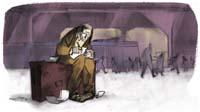Paul Erdös, travelling mathematician

He was carrying a semi-empty suitcase. It had an approximate length of 1.70 meters and would not reach 50 kilos. Socks and sandals on the feet and white hair on the head. Intense eyes behind thick glasses. It was four in the morning, but that didn't matter. He had no time to lose, he knew he would find a mathematician behind him. He knocked on the door. And when they opened him, in a smile and in curious English he said: "I feel open! ".
This was how Paul Erdös worked: from one mathematician to another in congresses, universities to universities. He had no fixed residence and all his goods entered it. I needed no more: "The goods are annoyances," he used to say.
If he knew that some mathematician was working with some interesting problem, he would visit him there, regardless of the country he was from, the continent or the one he was from. And there I would spend a few days doing math and writing some article in collaboration with the house mathematician. Then, he might ask his neighbor who would visit later. And if not, there will be some congress or place.
According to those around him, he was a nice man, strange, weird and somewhat crazy, but pleasant. People liked it in general and people liked it too. But if I wanted something, they were numbers. Mathematics was almost the only thing I had in mind. Friends cared for the rest. His friends provided him with accommodation and support, bought him clothes, paid taxes...
His passion for mathematics came from a child. Born in Budapest in 1913. His father and mother were teachers of mathematics, and his son also immediately demonstrated an exceptional mathematical gift. At 16, his father taught him infinite series and set theory. They subsequently became one of their two favorite themes, along with the theory of numbers.
At the age of twenty, as a university student, Bertrand demonstrated a theorem proposed in 1845 (between an integer and its double there is always a number first). Tchebychev had tried it in 1850, but its resolution was very complex, almost incomprehensible, and that of Erdös simple and elegant. Everyone was fascinated.
The following year, in 1934, he obtained a doctorate and obtained a scholarship to travel to Manchester. And in 1938 he went to the United States. There he worked at several universities. From this time on, his only goal was to solve math problems. In fact, Erdös was not a theory builder, but a problem solver. And there was nothing like that. He liked to solve problems that were very difficult, but had a simple, beautiful and easy to understand solution.
It wasn't more than a couple of years ago at the same university. In the course 1953-54, for example, he worked at Notre Dame University in Indiana. Although he was against the Church and organized religion, if it were to teach mathematics, it was indifferent that he was in a Catholic organization. When his friends took his hair, he replied: "The only thing that bothers me is that there are too many signs +".
Politics and religion did not interest him. He questioned the existence of God and called him "Supreme Fascist" or SF (Supreme Fascist). He accused him of hiding socks and passport, as well as holding back the most elegant mathematical tests. On the other hand, he called "The Book" an imaginary book in which God had written the best mathematical proofs. And when he found an especially beautiful test, he said "Hau Liburu da".
His peculiar vocabulary did not end there. The children were called "epsilon" (which in mathematics is often used for small values), the women were "older" and the men were "slaves", alcohol "poison", give a mathematical lecture "preach", what stopped doing mathematics was "dead" and those who died physically gone".
He was an eccentric man. And generous. The money also didn't have much value for Erdös, and the class or conference was the one that earned the most to help or reward young mathematicians. It offered prizes to problem-solvers. These prizes depended on the difficulty of the problem, from one dollar to 1,000 dollars. However, for the winners of these awards the honor of being able to solve a problem of Erdös was worth more than money.
And receiving Erdös's visit was also one of the best things that could happen to a mathematician. He collaborated with 485 mathematicians and signed a total of 1,475 articles (only Euler surpasses this brand). And he worked in mathematics in at least 25 countries. Faced with this fertility, in the mid-1960s, Erdös friends invented the "Erdös number". Erdös himself had number 0, the one who signed with him an article on 1, the one who had an article with someone with number 1, etc. The small number of Erdös was of course a pride.
In 1996 he stopped doing mathematics. A heart attack in Warsaw participating in a math meeting. Erdös did not die until he stopped living.
"In the end I'm not getting foolish," says the epitaph he wrote for himself.
Buletina
Bidali zure helbide elektronikoa eta jaso asteroko buletina zure sarrera-ontzian











